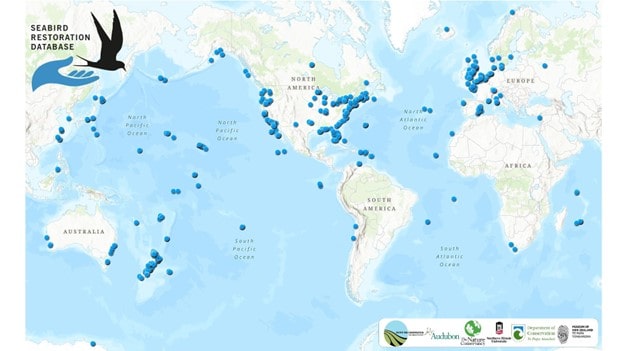Seabird Restoration Database
Project website: www.seabirddatabase.org
Partners: The Nature Conservancy, National Audubon Society, Northern Illinois University, the New Zealand Department of Conservation, Museum of New Zealand Te Papa Tongarewa.

The Seabird Restoration Database is a compendium of translocation and social attraction efforts systematically synthesized from nearly 1,400 resources and over 300 experts to inform seabird restoration best practices. This data science tool seeks to improve knowledge transfer of active restoration techniques among practitioners and enhance seabird conservation by providing the methods and outcomes from these activities. The Database also adds value as a knowledge-sharing product, where information on past projects can help place actions in a broader context for fundraising purposes, and for gaining broader support of seabird restoration in general.
Primary information in the database includes project location, target seabird species, method applied, project status and timeline, and outcomes for each active restoration effort. Secondary details included restoration site attributes (e.g., protected status, habitat enhancement, threat management), project justifications, source colony details, and challenges experienced that could impact outcomes.
As of 2022, the database includes 851 events targeting 138 species in 551 locations and 36 countries. This information was synthesized from nearly 1,400 resources and consultation with over 300 experts. The data is available as a searchable web map at seabirddatabase.org. Users can freely visit the website, request data, and filter data by location, species, and method to learn about when, where, and how active restoration has been used to restore seabird colonies. Note, sensitive locations were removed from the map. The results were also synthesized in a 2023 publication in the Proceedings of the National Academy of Sciences, which describes global restoration trends, applies a systematic process to measure success rates and response times since implementation, and examines global factors influencing outcomes. We provide management recommendations based on the results and have used the manuscript to develop a follow-up study on the drivers of observed restoration outcomes. Finally, we were awarded a climate mainstreaming grant from the Wildlife Conservation Society to adapt the database to determine active restoration opportunities for climate-sensitive seabirds in the US Pacific. In 2023 we will continue to communicate the results of this effort, analyze data to understand the enabling factors driving outcomes, and work with interested parties in the US to develop climate-adaptation restoration priorities for US Pacific Seabirds.



155 Tracking the global effort to reverse seabird declines with active restoration techniques. Proceedings of the National Academy of Sciences
